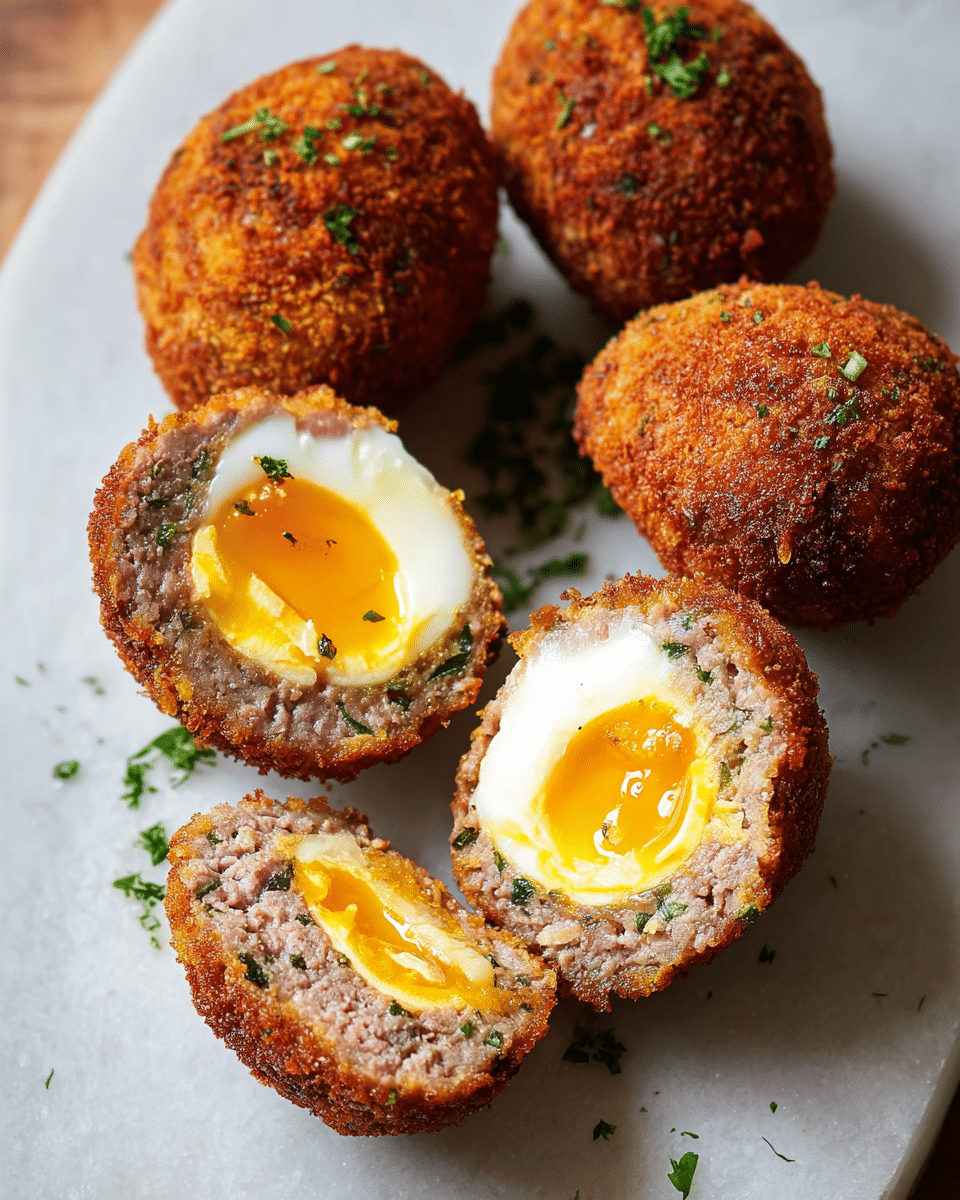The combination of tender, soft-boiled eggs wrapped in savory sausage and crispy breadcrumbs creates a satisfying contrast in every bite. Perfect for a party or casual meal, Scotch Eggs are guaranteed to impress with their golden crunch and savory flavor.
These Scotch Eggs can be served as a standalone snack or paired with your favorite dipping sauce for an added kick. Whether you’re hosting a brunch or just looking for a satisfying treat, these golden delights will be the talk of the table. The crispy exterior and soft, yolky interior make each bite a delicious experience. They’re the perfect comfort food to enjoy with friends and family.
Full recipe:
Ingredients:
-
6 large eggs
-
1 lb ground sausage (or meat of choice)
-
1/4 cup fresh parsley, chopped
-
1/2 teaspoon garlic powder
-
1/2 teaspoon onion powder
-
1/2 teaspoon dried thyme
-
1/2 teaspoon paprika
-
Salt and pepper to taste
-
1 cup all-purpose flour
-
2 large eggs (for dipping)
-
1 1/2 cups breadcrumbs
-
Vegetable oil for frying
Directions:
-
Bring a pot of water to a boil and gently add the eggs. Boil for 6-7 minutes for soft-boiled eggs, then transfer to an ice bath to cool. Peel once cooled.
-
In a large bowl, combine ground sausage, parsley, garlic powder, onion powder, thyme, paprika, salt, and pepper. Mix thoroughly.
-
Take a portion of the sausage mixture (about 2-3 tablespoons) and flatten it into a thin patty. Place a boiled egg in the center and mold the sausage around the egg to fully cover it. Repeat with the remaining eggs.
-
Dredge each scotch egg in flour, dip into beaten eggs, then coat in breadcrumbs.
-
Heat vegetable oil in a deep pan over medium heat. Fry the scotch eggs in batches until golden brown, about 5-7 minutes per batch. Remove and drain on paper towels.
-
Serve warm, enjoy!
Prep Time: 15 minutes | Cooking Time: 15 minutes | Total Time: 30 minutes
Kcal: 320 kcal per scotch egg | Servings: 6 scotch eggs
The History of Scotch Eggs
Scotch Eggs were first created in the 18th century and became popular as a convenient snack. The earliest versions are believed to have been sold by London department store Fortnum & Mason in 1738. These original Scotch Eggs were made with a delicate balance of seasoned meat, an egg wrapped inside, and then deep-fried to achieve that perfect golden crunch. Over the years, the dish has evolved, with many variations that include different kinds of meats, seasonings, and cooking methods. Today, Scotch Eggs are commonly enjoyed as a savory snack or appetizer in various cultures around the world. The dish’s adaptability has made it a beloved staple in casual dining and pub menus.
Why Scotch Eggs are a Favorite Snack
What makes Scotch Eggs so irresistible is their perfect balance of textures. The rich, meaty sausage coating adds depth and flavor, while the soft-boiled egg at the center provides a creamy, slightly runny yolk that contrasts beautifully with the crisp outer shell. The crunchy breadcrumbs on the outside help lock in the flavors and create a satisfying bite. Scotch Eggs are not just tasty but also portable, making them a perfect snack for outdoor events, road trips, or picnic gatherings. They can be served hot or cold, and their versatility allows for various accompaniments, such as dipping sauces or salads, making them even more delightful.
How to Customize Your Scotch Eggs
While the classic Scotch Egg features sausage meat, the dish can easily be customized to suit a variety of tastes and dietary preferences. For example, those who follow a vegetarian or vegan diet can swap the sausage for plant-based alternatives like lentils, beans, or a mixture of grated vegetables. You can also experiment with different types of sausages, such as spicy chorizo or herbed chicken sausage, to give your Scotch Eggs an added layer of flavor. For a lighter version, you can bake the Scotch Eggs instead of deep-frying them. This will give you a slightly healthier version while still maintaining the signature crispy exterior. Additionally, you can season the meat filling with different herbs and spices, such as cumin, coriander, or fresh herbs like parsley, thyme, or rosemary, to elevate the dish further.
Serving Suggestions for Scotch Eggs
Scotch Eggs can be served in a variety of ways, depending on the occasion. If you’re hosting a brunch, they can be paired with a fresh green salad, roasted vegetables, or a tangy dipping sauce, like mustard, ketchup, or a spicy aioli. For a more substantial meal, serve the Scotch Eggs alongside a hearty potato salad or a bowl of homemade soup. These eggs can also be enjoyed as a snack with a side of pickles or chutney for a burst of acidity that balances out the richness of the meat and egg. Additionally, they make for a great addition to a charcuterie board, adding both a savory and textural element to the spread.
Scotch Eggs for Every Season
While Scotch Eggs are a year-round favorite, they can be especially delightful during certain seasons. In the spring and summer, when the weather is warmer, Scotch Eggs are perfect for outdoor activities like picnics, barbecues, or road trips. Their portability makes them easy to transport and share with friends and family. In colder months, they can serve as a comforting snack or appetizer at a cozy gathering, paired with a warming drink like mulled wine, cider, or a hot cup of tea. Their rich, hearty filling is the perfect counterbalance to the chill of the season, offering both warmth and flavor in each bite.
The Best Way to Fry Scotch Eggs
Deep-frying is the traditional method for cooking Scotch Eggs, giving them that signature crispy texture. However, the key to perfect frying is to ensure the oil is at the right temperature. If the oil is too hot, the exterior will burn before the sausage has had a chance to cook through. If it’s not hot enough, the Scotch Eggs will absorb excess oil, resulting in a greasy, soggy texture. Aim to heat the oil to around 350°F (175°C) and fry the eggs in batches, turning them occasionally to ensure they cook evenly. Alternatively, you can also bake the Scotch Eggs at a high temperature to achieve a healthier, less greasy version.
How to Store Scotch Eggs
Scotch Eggs can be stored easily for later consumption, which makes them a great make-ahead option. After they have cooled completely, store them in an airtight container in the refrigerator for up to 3 days. If you’d like to reheat them, simply place them in the oven or air fryer at 350°F (175°C) for 10 minutes, ensuring they are heated through and regain their crispy exterior. They can also be frozen if you want to keep them for a longer period. To freeze Scotch Eggs, wrap them individually in plastic wrap or foil and place them in a freezer-safe bag. When you’re ready to enjoy them, bake or fry them from frozen until they are golden and hot.
Health Benefits of Scotch Eggs
Though often considered a comfort food, Scotch Eggs do have some nutritional benefits. Eggs are a great source of protein, healthy fats, and essential vitamins like B12 and choline, which support brain health. Sausage, depending on the type used, can also provide protein and fat, while breadcrumbs add fiber if whole wheat varieties are used. That said, Scotch Eggs are quite indulgent, especially when deep-fried, so they are best enjoyed in moderation. However, you can always opt for a baked version and adjust the ingredients to make them healthier, such as using lean meats or plant-based sausage alternatives.
Conclusion
Scotch Eggs are a fantastic way to enjoy a snack that is both indulgent and satisfying. Their versatility, rich history, and ability to be customized make them a timeless dish loved by many. Whether you’re making them for a family gathering, a picnic, or simply as a fun weekend project, Scotch Eggs offer something for everyone. With a crispy exterior, tender sausage, and creamy egg center, these little bites of heaven are perfect for any occasion. Don’t be afraid to experiment with different flavors and cooking methods to make this dish your own. So, go ahead and give Scotch Eggs a try—your taste buds will thank you!






